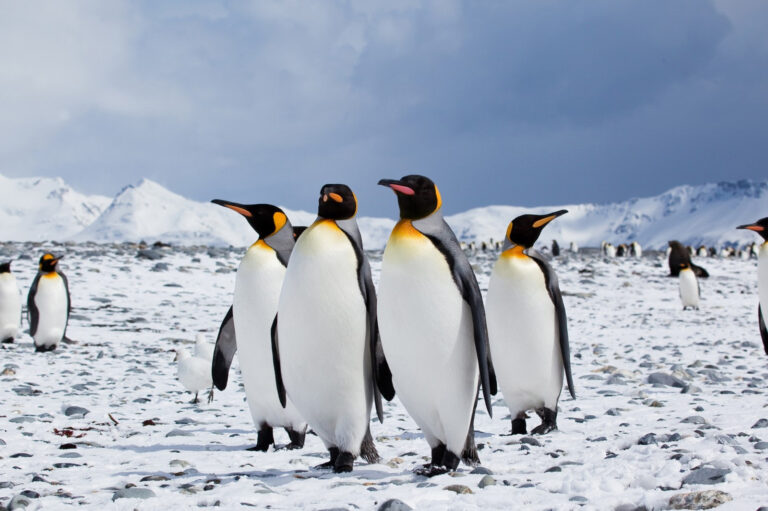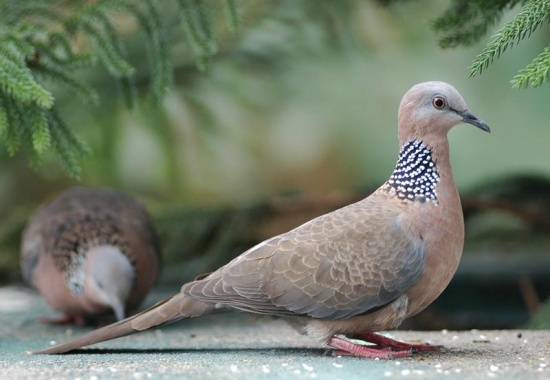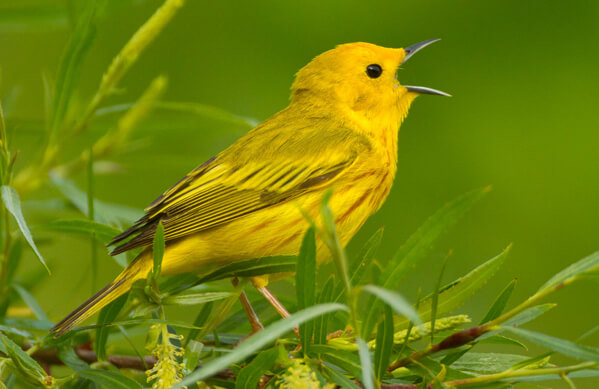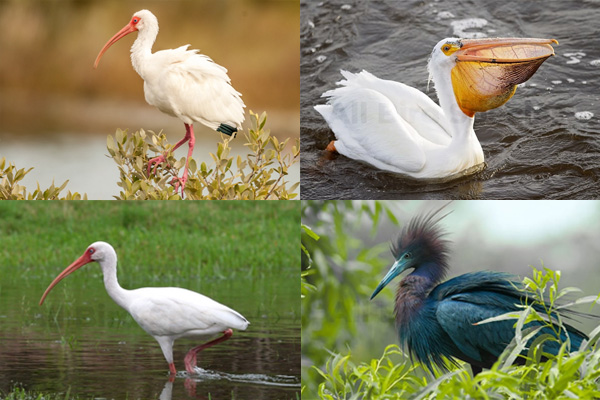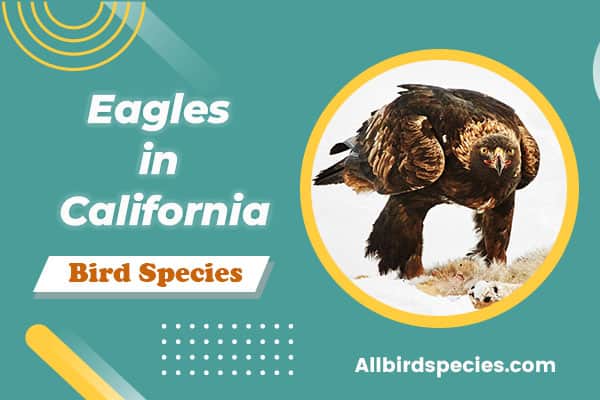9 Yellow Birds With Black Wings (ID Guide With Photos)
This guide will show you ten beautiful birds with yellow feathers and black wings. We’ll look at their unique traits, what they eat, and where they live. You’ll see species like the American Goldfinch, Baltimore oriole, and Western tanager. By the end, you’ll love these birds even more and understand their world better.
Introduction to Yellow Birds with Black Wings
Yellow birds with black wings catch our eye with their bright colors and unique look. They live in many places in North America. They make our gardens and parks more lively.
These birds have bright feathers for a reason. They draw in friends and hide among plants. Learning to spot them is fun for bird lovers.
We’ll look at some special birds, where they live, and how they act. This will help us love these birds more.
Here’s a brief overview of some of the yellow birds with black wings we may encounter:
| Species | Habitat | Behavior | Diet |
|---|---|---|---|
| American Goldfinch | Open fields, gardens | Social, agile fliers | Seeds, dandelions |
| Baltimore Oriole | Woodlands, orchards | Vocal, territorial | Fruits, nectar |
| Scott’s Oriole | Deserts, scrublands | Solitary, elusive | Insects, fruits |
| Yellow-Headed Blackbird | Wetlands, marshes | Colonial, protective | Insects, seeds |
This introduction starts our journey with these amazing yellow birds. Let’s dive into this colorful adventure together!
1. American Goldfinch
The American goldfinch is a favorite among yellow birds in North America. Its bright color and friendly nature make it stand out. The male’s bright yellow body and black wings with white stripes catch our eye easily.

The females have a softer yellow color. This helps them hide while they are nesting.
Appearance and Characteristics
The males of the American goldfinch show off their bright yellow during breeding season. Their sleek bodies and black wings with yellow bodies make them look elegant in flight. They are small, about 4.5 to 5 inches long, and are fun to watch as they move through trees and shrubs.
Diet and Feeding Habits
American goldfinches love to eat seeds. They enjoy thistle seeds, sunflower seeds, and seeds from weeds and flowers. They hang upside down to get seeds from plants. This shows how they adapt to find food and survive.
Nesting and Migration Patterns
These birds build their nests in shrubs or small trees. They use plant fibers, spider silk, and other materials to make their nests. Some goldfinches migrate, but others stay where food is always available. This helps them live in different places.
2. Baltimore Oriole
The Baltimore oriole is a favorite among yellow birds with black wings. They have bright orange and black feathers. This makes them stand out in nature.
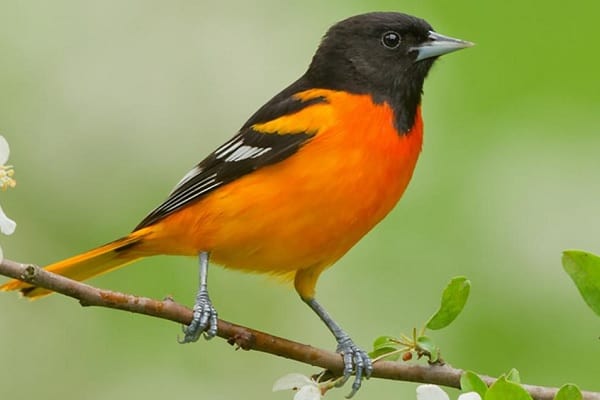
Male Baltimore orioles are very bright orange. Females are more yellow. Their looks are truly special for bird lovers.
Distinctive Features
These birds are known for more than their bright colors. They have a thin body, long wings, and a long tail. This makes them look elegant.
Their songs are like beautiful whistles. This adds to their charm. Their looks and sounds make them stand out.
Feeding Preferences
Baltimore orioles eat nectar, fruit, and insects. They like sugar-water feeders and foods like jelly and berries. They come to these foods during their migrations and when they’re raising their young.
Habitat and Breeding Season
In late spring, they live in wooded areas near water. They build nests in trees, hanging from branches. This keeps their babies safe.
These birds live in many places, from cities to parks. They help keep nature healthy.
3. Scott’s Oriole
Scott’s oriole is a bright yellow bird that birdwatchers love to see. It has sleek black wings that make it stand out. Let’s learn how to spot it and what it eats.
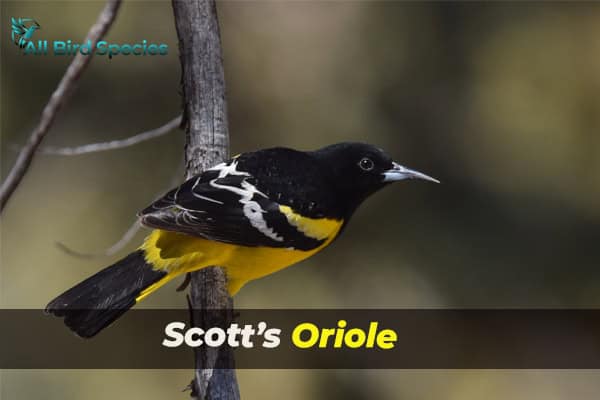
Identification Tips
To spot Scott’s oriole, look for these things:
- Coloration: The male is bright yellow with black wings. Females are less colorful.
- Size: They are about 7.5 to 8 inches long.
- Call: Their songs and calls help you find them in the wild.
These tips help us spot Scott’s orioles in dry areas and deserts.
Dietary Needs
Scott’s orioles eat nectar from flowers and help pollinate plants. They also eat:
- Nectar from flowers
- Berries and fruits
- Insects for Protein
By eating these foods, Scott’s orioles help the ecosystem. They are also interesting birds to watch.
4. Western Tanager
The Western tanager is a stunning yellow bird with bright colors. Males have a vivid yellow body, black wings, and a bright red head. Females are less flashy but still stand out with their yellow underparts.
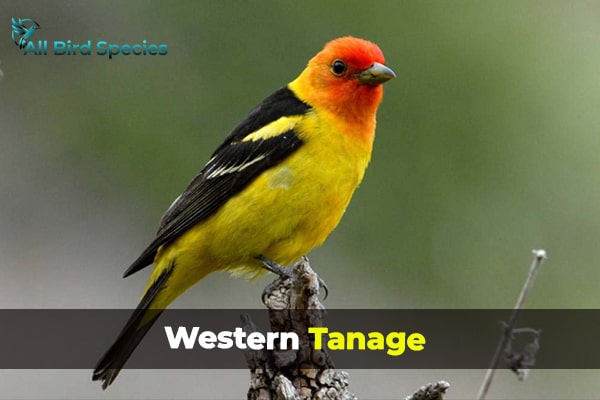
These birds love to move through forests and woodlands. They are easy to spot during their migration.
Color Variations
The Western tanager is known for its bright colors. Males have a striking yellow and black look. Females have yellow and olive colors that help them blend in but still look unique.
Where to Spot Them
Spring and summer are the best times to see these birds. They live in places with lots of trees. You can find them in:
- Deciduous forests
- Woodlands
- River valleys
- Mountains
Going to these places increases your chances of seeing these beautiful birds. It makes birdwatching more exciting.
5. Yellow-Rumped Warbler
The yellow-rumped warbler is a bird with bright yellow marks on its throat and rump. They live in many places, from woods to cities. We see their lively bird behavior in different spots, especially their flocking habits. These yellow birds join together when they migrate, showing how they work together for safety.
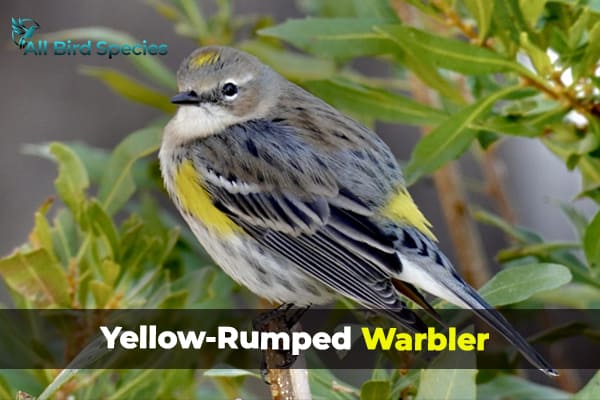
Behavior and Social Structure
The yellow-rumped warbler has amazing social ways that help them survive. They often fly together during migration. This helps them in many ways, like:
- Staying safe from predators
- Finding food better together
- Navigating better in groups
They eat mostly insects and berries, playing a big role in their ecosystems. Learning about their social life shows us how they live as both individuals and a community in our world.
| Aspect | Description |
|---|---|
| Social Structure | Forms flocks, particularly during migration |
| Diet | Insects and berries |
| Habitat | Woodlands, urban areas, and more |
| Flocking Behavior | Increases safety from predators |
6. Wilson’s Warbler
The Wilson’s warbler is a bright yellow bird with black wings. It has a vibrant color and unique features. This small songbird is a joy for birdwatchers to spot.
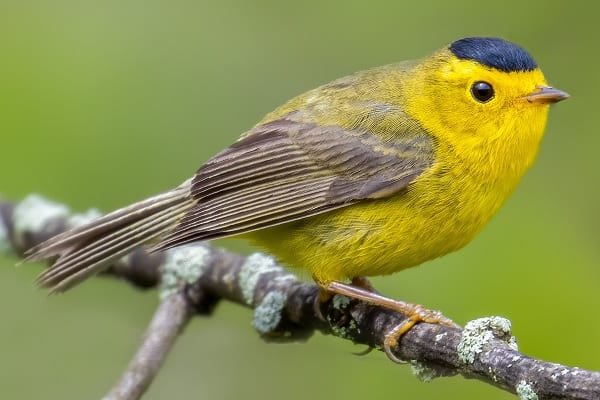
Identifying This Small Bird
Look for the Wilson’s warbler’s key traits to spot it. The male shines with bright yellow feathers and a black cap in spring and summer. Its happy calls fill the air, making it fun to listen for.
Watching them jump from branch to branch is exciting. It leads to great sightings.
Common Habitats
Wilson’s warblers live in certain places that help them nest and find food. They love dense shrubs, riparian zones, and thickets near streams. These spots keep them safe from predators and give them lots of insects and spiders to eat.
During migration, they move through different wooded areas. They blend in well with their surroundings.
Other Notable Yellow Birds with Black Wings
Exploring the world of yellow birds often leads us to the golden-winged warbler, masked yellowthroat, and yellow-headed blackbird. These birds catch the eye with their unique looks and where they live. They make the bird world more interesting.
7. Golden-Winged Warbler
The golden-winged warbler has striking wing patterns that grab your attention. It lives in shrubs, eating insects and seeds. During migration, it travels far, showing how it can adapt to different places. Its songs add a sweet sound to nature.

8. Masked Yellowthroat
The masked yellowthroat stands out with its black mask. It lives near wetlands, moving through tall grasses and reeds. It eats insects and plants, playing a big part in its ecosystem. Its bright colors make it stand out in the greenery.

9. Yellow-Headed Blackbird
The yellow-headed blackbird has a bright yellow head and throat. It lives in marshlands, often seen on reeds or eating on the ground. This bird helps control insect numbers. Seeing it in the wild is a treat for bird lovers.

Importance of Birdwatching and Conservation
Watching birds brings us joy and helps us appreciate the world around us. Seeing yellow birds with black wings teaches us about their important roles. They help with pollination and controlling pests, keeping our environment healthy.
We must protect yellow birds from threats like losing their homes, climate change, and pollution. It’s our job to spread the word about protecting these birds. By taking action, we can keep our planet balanced for the future.
Sharing the need for conservation and birdwatching encourages others to help. Together, we can protect the homes of many birds. Let’s love nature together and work for a better future.
Check Our Previous Articles:
| How to Stop Birds from Chirping |
| Pineapple Green Cheek Bird |
| Brown Bird with a Long Beak |
| Albino Crows: Meaning, Symbolism, And Myths |
| Albino Peacocks: Everything You Need To Know |
Final Thoughts:
As we finish our look at yellow birds with black wings, we see how much they add to our birdwatching. We’ve learned about the American Goldfinch, Baltimore Oriole, and Wilson’s Warbler. Each one is special and fun to watch.
Learning about their looks, what they eat, and where they live helps us spot them better. This makes our birdwatching more exciting. It also brings us closer to these colorful birds.


